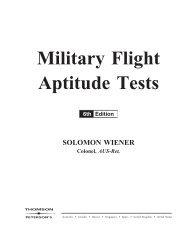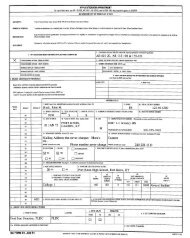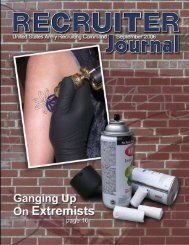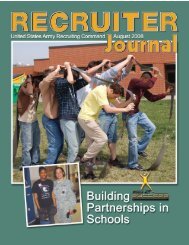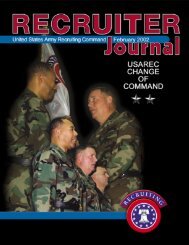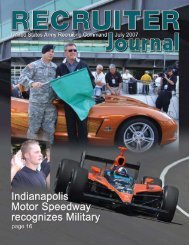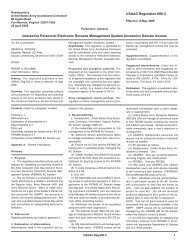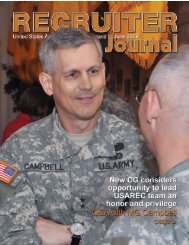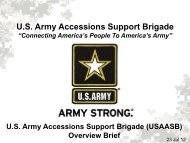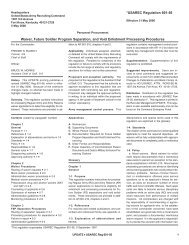19 Dec Cover.pmd - USAREC - U.S. Army
19 Dec Cover.pmd - USAREC - U.S. Army
19 Dec Cover.pmd - USAREC - U.S. Army
You also want an ePaper? Increase the reach of your titles
YUMPU automatically turns print PDFs into web optimized ePapers that Google loves.
UNCLASSIFIED<br />
<strong>USAREC</strong> Pamphlet 27-65<br />
Personnel—General<br />
Procedural<br />
Guide for the<br />
United States<br />
<strong>Army</strong> Recruiting<br />
Command<br />
Investingating<br />
Officer<br />
Headquarters<br />
United States <strong>Army</strong> Recruiting Command<br />
1307 3rd Avenue<br />
Fort Knox, Kentucky 40121-2726<br />
20 <strong>Dec</strong>ember 2012
Headquarters<br />
United States <strong>Army</strong> Recruiting Command<br />
1307 3rd Avenue<br />
Fort Knox, Kentucky 40121-2726<br />
20 <strong>Dec</strong>ember 2012<br />
For the Commander:<br />
HEATHER L. GARRETT<br />
Colonel, GS<br />
Chief of Staff<br />
Official:<br />
Legal Services<br />
Procedural Guide for the United States <strong>Army</strong> Recruiting Command<br />
Investigating Officer<br />
JOSEPH P. BONANO<br />
Director, Information Management<br />
Summary. This pamphlet provides information<br />
on how to conduct thorough, impartial,<br />
and objective investigations. It ex-<br />
plains the basic techniques and procedures<br />
of the investigative process.<br />
Applicability. This pamphlet is applicable<br />
to anyone appointed to conduct an investigation<br />
within the United States <strong>Army</strong> Recruiting<br />
Command.<br />
Impact on New Manning System. The<br />
pamphlet does not contain information that<br />
affects the New Manning Sytem.<br />
Suggested improvements. The pro-<br />
*This pamphlet replaces the <strong>USAREC</strong> P amphlet 27-65, dated 1 April <strong>19</strong>94.<br />
<strong>USAREC</strong> Pam 27-65 • 20 <strong>Dec</strong>ember 2012<br />
UNCLASSIFIED<br />
*<strong>USAREC</strong> Pamphlet 27-65<br />
ponent agency of this pamphlet is the Office<br />
of the Staff Judge Advocate. Users<br />
are invited to send comments and suggested<br />
improvements on DA Form 2028<br />
(Recommended Changes to Publications<br />
and Blank Forms) directly to HQ <strong>USAREC</strong><br />
(RCSJA), Fort Knox, KY 40121-2726.<br />
Distribution. This pamphlet is available<br />
in electronic media only and intended for<br />
command level A.<br />
i
Contents (Listed by paragraph and page number)<br />
Purpose • 1, page 1<br />
References • 2, page 1<br />
Explanation of abbreviations • 3, page 1<br />
Mission • 4, page 1<br />
Preparation for duty as an IO • 5, page 1<br />
Preinterview checklist • 6, page 1<br />
Conducting the investigation • 7, page 2<br />
Postinterview checklist • 8, page 4<br />
Preparing your report • 9, page 5<br />
Appendix<br />
A. References, page 17<br />
B. Examples of Statements and Documentation, page 18<br />
Figure List<br />
Figure 1: Sample memorandum of an appointment, page 6<br />
Figure 2: Sample Privacy Act Statement, page 8<br />
Figure 3: Sample memorandum of Report of Investigation, page 9<br />
Figure 4: Sample memorandum of a good ROI, page 11<br />
Figure 5: Sample memorandum of a poor ROI, page 14<br />
ii<br />
<strong>USAREC</strong> Pam 27-65 • 20 <strong>Dec</strong>ember 2012
1. Purpose<br />
This pamphlet provides information on how to conduct thorough and impartial investigations. It should be used<br />
with the prescribing directive under which the investigating officer (IO) was appointed. This guide is designed to<br />
explain the basic techniques and procedures of the investigation. If this pamphlet conflicts with the prescribing<br />
directive, the prescribing directive will govern. If this pamphlet conflicts with AR 15-6 or any other <strong>Army</strong> regulation,<br />
the <strong>Army</strong> regulation will govern.<br />
2. References<br />
For related publications and blank forms see appendix A.<br />
3. Explanation of abbreviations<br />
a. FSTP — Future Soldier Training Program<br />
b. IO — investigating officer<br />
c. MEPS — Military Entrance Processing Station<br />
d. RI — recruiting impropriety<br />
e. ROI — report of investigation<br />
f. <strong>USAREC</strong> — United States <strong>Army</strong> Recruiting Command<br />
g. BJA — Brigade Judge Advocate<br />
4. Mission<br />
The mission of the IO is to conduct a thorough, impartial investigation, determine the facts of the case, and provide<br />
the appointing authority with findings and recommendations that properly apply governing standards, regulations, and<br />
laws. An IO’s duty takes precedence over all other duties.<br />
5. Preparation for duty as an IO<br />
Your investigating duties will be an additional duty, but will take priority over your normal duties. Most of the<br />
preparation for gathering evidence can take place at your normal duty station. Proper advanced planning will allow<br />
you to do a thorough investigation and meet the required suspense dates without being away from your normal<br />
duties or duty station for an extended period of time. Before you begin to collect evidence you must:<br />
a. Read the memorandum of appointment and any supporting documentation to ensure you fully understand what<br />
the appointing authority wants you to investigate. However, be aware of other potential areas of investigation that<br />
may arise in the course of your investigation. Should your investigation uncover new misconduct, you must notify<br />
your legal advisor and coordinate with the appointing authority before expanding the scope of your investigation.<br />
Informal investigations will be appointed in writing (see figure 1).<br />
b. Study AR 15-6, the prescribing directive, and this pamphlet. These publications provide guidance on procedures<br />
and what is expected in your report of investigation (ROI).<br />
c. Understand the regulations, policies, and directives that govern the subject area of your investigation. You<br />
must consult your Brigade Judge Advocate (BJA) or legal advisor prior to investigating and they will assist in<br />
obtaining these references and will aid in clarification or interpretation of any matters, including possible search<br />
and seizure questions and authorizations.<br />
d. Your BJA or legal advisor will assist in defining the allegation(s) and assist in determining what evidence may<br />
be relevant. This is the who, what, where, when, why, and how of the investigation.<br />
e. You must decide what is the best source for the needed evidence. There are three general categories of<br />
evidence: physical evidence, documentary evidence, and testimonial evidence. Assistance in obtaining the best<br />
evidence should come from your BJA or legal advisor.<br />
6. Preinterview checklist<br />
Before gathering evidence, ask these questions of yourself:<br />
a. Have you read the letter of appointment?<br />
b. Are the allegations clearly stated and understandable?<br />
c. Have you gathered the required regulations, policy letters, messages, and directives?<br />
d. Do you understand the elements of proof for the stated allegations (for example, see <strong>USAREC</strong> Reg 601-45,<br />
<strong>USAREC</strong> Reg 600-25, and Manual for Courts-Martial, United States)?<br />
e. Have you consulted with your BJA or legal advisor?<br />
<strong>USAREC</strong> Pam 27-65 • 20 <strong>Dec</strong>ember 2012<br />
1
f. Have you identified the documentary and/or physical evidence necessary to complete your investigation?<br />
g. Have you identified the witnesses who must be questioned and ascertained their availability and willingness to<br />
provide sworn testimony?<br />
h. Do you have any possible personal disqualifications to relate to the appointing authority? Examples would be<br />
duty relationship, friendship with any witness, or being junior to any Soldier whose conduct reasonably may be in<br />
issue.<br />
i. Is an officer or civilian employee senior to you possibly guilty of dereliction of duty, or other violations of law<br />
or regulations? If so, report this immediately to the appointing authority.<br />
j. Have you identified who must receive a <strong>USAREC</strong> Form 722 (Privacy Act Statement) per paragraph 7c(4)?<br />
k. Have you identified which witnesses are suspected of criminal offenses, including violation of punitive <strong>Army</strong><br />
or <strong>USAREC</strong> regulations, and prepared their DA Form 3881 (Rights Warning Procedure/Waiver Certificate)?<br />
l. Have you prepared to conduct a thorough, impartial, and objective investigation?<br />
m. Will witnesses be interviewed in person? If not possible, by phone?<br />
n. Have you prepared areas of questioning?<br />
o. What order will witnesses be interviewed?<br />
p. Should the complainant be interviewed first?<br />
7. Conducting the investigation<br />
Once you are ready to begin the investigation, the following steps should be taken.<br />
a. Obtain any documentary or physical evidence that is available. In most recruiting impropriety (RI) cases this<br />
will include applicable documents from the applicant’s or Soldier’s guidance counselor resource center/electronic<br />
records management (GCRc/ERM) enlistment files and Contact History (if you need information that you cannot<br />
access, contact the applicable battalion executive officer (XO) to obtain such information for you). Court checks<br />
and medical records are other documents frequently required during RI investigations. Do not overlook statements<br />
previously provided to others by participants such as police reports, letters to commanders, and statements taken at<br />
the Military Entrance Processing Stations (MEPS). Examples of documents and interviews required for common<br />
allegations are at appendix B. Copies of all documents that assist in substantiating or refuting the allegation will be<br />
included as a part of the investigation.<br />
b. Review all documentary evidence and decide what witness statements you need. Identify personnel with whom<br />
you need to talk, what subject areas need to be discussed, and what questions you are going to ask. <strong>Dec</strong>ide in what<br />
order you will interview witnesses. In most cases the complainant should be interviewed first and the person against<br />
whom allegations have been made should be interviewed last. This ensures that the allegations are investigated<br />
thoroughly and that the person against whom the allegations have been made has an opportunity to refute or explain<br />
any adverse evidence. It is essential that you prepare in advance for each witness interview. What do you expect to<br />
learn from the witness? What subject areas need to be examined? By making notes in advance about these subject<br />
areas, you are less likely to forget an important area during the interview. Writing a list of questions in advance is<br />
not recommended. Such interviews tend to become too structured, and logical areas of further questioning are<br />
often overlooked or forgotten. A list of topics or subject areas is preferred. A short list of topics helps guide an<br />
interview and ensures that each area is examined completely before moving to the next area of questioning.<br />
c. Conduct witness interviews.<br />
(1) <strong>Dec</strong>ide the time and place of each witness interview. Coordinate the presence of military and civilian<br />
government employees with their supervisor. Because civilians not affiliated with <strong>Army</strong> or DoD are not under any<br />
obligation to provide a statement, you should strive to find a convenient time and place to conduct an interview and<br />
obtain a statement.<br />
(2) If you suspect a Soldier of violating the Uniform Code of Military Justice (UCMJ) (to include violation of a<br />
punitive regulation), you must read the Soldier his/her rights under Article 31, UCMJ. To avoid any problems,<br />
complete a DA Form 3881, have the Soldier make a selection to remain silent or make a statement, sign it, and<br />
attach it in the ROI. Do not advise military witnesses of their rights if they are not suspected of any offense. If in<br />
doubt as to whether it is necessary to read a witness their rights, call the BJA or legal advisor for guidance.<br />
(3) Before interviewing any civilians, including civilian employees of the United States, contractors, or nongovernment<br />
civilians, consult with your BJA or legal advisor. Your BJA or legal advisor will assist you in determining<br />
the status of the civilian(s) to be interviewed and the rules that will apply to each specific interview. The rules may<br />
vary so it is very important that you talk to your BJA or legal advisor in advance. Finally, if in doubt as to whether it<br />
2<br />
<strong>USAREC</strong> Pam 27-65 • 20 <strong>Dec</strong>ember 2012
is necessary to read a civilian witness their rights (or whether you possess the authority to do so), call the BJA or<br />
legal advisor for guidance.<br />
(4) <strong>USAREC</strong> Form 722, Privacy Act Statement (figure 2) will be provided to a witness if the report will be filed<br />
in a system of records from which it can be retrieved by reference to the name, social security number, or other<br />
such personal identifier of the witness. This will normally include the subject(s) of the investigation, including<br />
applicants in recruiting impropriety investigations and victims in investigations of alleged misconduct. If in doubt<br />
as to whether the advisement should be provided, consult your BJA or legal advisor.<br />
(5) Good interviews tend to have distinct phases.<br />
(a) Phase I: Introduction and rights advisements, as appropriate.<br />
(b) Phase II: Develop a narrative. Let the person tell their version of events orally. Ask questions to clarify but<br />
not to narrow the discussion.<br />
(c) Phase III: Commit the narrative to writing. Have the interviewee write down their version of events in detail.<br />
(d) Phase IV: Use a question and answer (Q&A) format to clarify and refine the witness’s statement.<br />
(6) All statements will be sworn, if possible. Except in unusual circumstances DA Form 2823 (Sworn Statement)<br />
will be used. Most IOs find it helpful to have a general discussion with the witness first, then ask specific questions.<br />
During the interview the IO should take notes or use a tape recorder, but use of a tape recorder is not encouraged. If<br />
the conversation is recorded, you must notify the witness of your intention at the beginning of the tape. If you are<br />
taping a telephonic conversation, you must obtain the other person’s consent. The statements should be typed so<br />
they can be easily read; if typed statements are not possible, have the witness print legibly. Avoid the temptation to<br />
make the written statements overly short after an extensive interview. Witness statements that are appended to the<br />
ROI must support the substance of your report. Generally oral testimony of a witness may not be used in your<br />
report unless the content has been reduced to writing. If you must consider oral testimony in reaching your findings<br />
and recommendations, you must reduce the oral testimony to writing—in the format of a memorandum for record<br />
or record of conversation. It is best to have the individual review what you have prepared and sign the document<br />
once they have verified it is an accurate reflection of their statement. Include the memorandum with the report as<br />
a substitute for a sworn statement.<br />
(7) If one witness contradicts another witness, get each witness to fully clarify their statements. This may require<br />
reinterviewing the earlier witness. This ensures that witnesses have an opportunity to explain contradictory statements.<br />
(8) Some things to do when interviewing witnesses:<br />
(a) Take charge of the interview.<br />
(b) Get the witness to explain thoroughly and be specific. For example, if the witness says “someone at the<br />
recruiting station told me X; ask the witness who told them X (that is, get a name or description of the person).<br />
(c) Develop the facts completely; do not leave questions unanswered.<br />
(d) Honor the rights of witnesses.<br />
(e) Be fair.<br />
(f) Be professional.<br />
(g) Consciously consider your demeanor during the interview because you represent the <strong>Army</strong>.<br />
(h) Be objective and discreet. Because you are required to be fair and unbiased, do not presume the guilt or<br />
innocence of any party before completing the investigation. For example, when a recruiter is accused of providing<br />
a ringer for testing, look for evidence to establish that a ringer was used and who (applicant or recruiter) was<br />
responsible for obtaining the services of the ringer.<br />
(i) Give the witness an opportunity to think.<br />
(j) Check for loose ends. Try to do this before concluding each interview. Check your preparatory notes for the<br />
information you expected to gain from the witness and ensure you’ve exhausted their knowledge of these facts.<br />
(k) Instruct the witness not to speak with other witnesses. Ensure witnesses are aware that it could be a violation<br />
of <strong>USAREC</strong> Reg 601-45 to speak to other witnesses about the subject matter being investigated before the<br />
investigation has been completed.<br />
(l) Be thorough. Ensure witnesses explain ambiguous terms such as “affair” or “relationship.” Focus on collecting<br />
the facts. Ask what conduct the witness observed and how that conduct led them to believe the “affair” or “relationship”<br />
happened.<br />
(m) Ask witnesses if they know anyone else who should be interviewed or can confirm what they have just told<br />
you.<br />
(n) If during an interview you refer to a document/exhibit, such as to determine if the witnesses recognizes it,<br />
identify the document in the witness statement and make sure the document is attached as an exhibit to the ROI.<br />
<strong>USAREC</strong> Pam 27-65 • 20 <strong>Dec</strong>ember 2012<br />
3
(9) In summary, each witness should describe in detail the occurrence (that is, enlistment process, relationship,<br />
etcetera,) and his or her involvement. After this is accomplished, additional questions will most likely be needed to<br />
clarify or explain unresolved issues.<br />
(10) Some things NOT TO DO when interviewing witnesses:<br />
(a) Do not browbeat, threaten, or intimidate.<br />
(b) Do not interview the witness in the presence of anyone else involved in the investigation. However, minors<br />
may need to be interviewed in the presence of the parent, guardian, or with proper consent, the presence of another<br />
adult.<br />
(c) Do not make promises, including promises of confidentiality to any person. Promises of confidentiality<br />
will not be made to any person without prior authorization by the <strong>USAREC</strong> Staff Judge Advocate (SJA).<br />
(d) Do not mislead.<br />
(e) Do not give advice to the witness.<br />
(f) Do not give the impression that any specific adverse action will be taken against anyone.<br />
(g) Do not compromise yourself by drinking alcoholic beverages with the witness.<br />
(h) Do not lose your temper or patience.<br />
(i) Do not make snide remarks.<br />
(j) Do not tell an untruth to get a truth.<br />
(k) Do not be embarrassed by periods of silence while the witness contemplates a question or an answer.<br />
(l) Do not ask questions that simply state the conclusion desired or that can be answered “yes” or “no.” For<br />
example, don’t ask an applicant whether they were coerced or pressured by their recruiter. Instead, ask the applicant<br />
what their recruiter said or did.<br />
(m) Do not take two witnesses, such as a mother and applicant, and let them sign the same witness statement.<br />
(n) Do not use double negatives in your questions.<br />
(o) Do not talk about your investigation with friends, witnesses, or other people who do not have an official need<br />
for the information. Don’t tell the person against whom allegations have been made that you will be making certain<br />
findings and recommendations. Gossiping about the investigation undermines confidence in the fairness and<br />
impartiality of the IO.<br />
d. Recruiting Improprieties (RIs). Investigations into RIs revolve around three essential questions. What<br />
happened? What should have happened? And, does the difference between what did happen and what should have<br />
happened constitute an RI. When investigating what happened, ensure you gather as much information as possible.<br />
(See appendix B for examples of necessary witness statements and documents for different types of RI investigations.)<br />
If the IOs findings are deficient, the command may or may not be able to determine what happened based on the raw<br />
evidence collected. When investigating what should have happened, make sure you consult the appropriate <strong>Army</strong><br />
and <strong>USAREC</strong> publications (that is, Regulations, Pamphlets, the Smartbook, and other publications). Additionally,<br />
you should consult with Recruiting Standards Directorate personnel or other subject matter experts as necessary to<br />
answer technical questions you might have. Do not rely solely on local practices, which may or may not reflect the<br />
proper standard. When investigating the third question (that is, whether the conduct amounts to an RI) you should<br />
consult with your legal advisor. Always consider the different theories of RI to see if one or more apply. Often,<br />
one person is telling the truth and another person is lying. Explain why you believe one person over the other.<br />
8. Postinterview checklist<br />
After gathering evidence, ask these questions of yourself:<br />
a. Who are all the persons identified by the original allegation(s)?<br />
b. Are there additional witnesses identified through your review of documents and/or taking of sworn statements<br />
who should be interviewed?<br />
c. Have sworn statements been taken from all witnesses? If not, explain why it is impossible to do so.<br />
d. For each finding, does the evidence show:<br />
(1) What happened?<br />
(2) What suspected events did not occur?<br />
(3) What laws, regulations, directives, or policies were violated?<br />
(4) When the events occurred (time and date)?<br />
(5) Who observed the events?<br />
(6) Where events took place?<br />
4<br />
<strong>USAREC</strong> Pam 27-65 • 20 <strong>Dec</strong>ember 2012
(7) Who or what caused the events to happen?<br />
(8) Were any other parties involved but not initially identified?<br />
(9) How or why the events occurred?<br />
e. Who are the immediate supervisors, and where were they when the events occurred?<br />
f. Is each witness credible - if not, why not? Describe the demeanor of the witness and why the demeanor leads<br />
you to believe the witness is credible or lying. Ask yourself whether any witness has an incentive to lie. If so,<br />
explain what that incentive is, why you think it is important, and why you believe the witness is lying (or not).<br />
g. Are there any unanswered questions or issues? Do you have to re-interview a witness or witnesses to clarify<br />
or explain an important fact.<br />
h. Is each proposed finding supported by a greater weight of the evidence than supports a contrary conclusion?<br />
Does the evidence point to a particular conclusion that is more credible and probable than any other conclusion?<br />
(This is the preponderance of evidence standard described by AR 15-6, paragraph 3-9b.)<br />
9. Preparing your report<br />
a. As an exception to policy DA Form 1574 (Report of Proceedings by Investigating Officer/Board of Officers)<br />
will not be used for the Report of Informal Investigations conducted within <strong>USAREC</strong> unless specifically directed<br />
by the appointing authority in the memorandum of appointment. Informal investigations will be reported using the<br />
format at figure 3. Use tab dividers between each enclosure. Be sure to include an index of tabs. If the ROI is over<br />
25 pages, fasten the entire ROI together at the top with a two-hole fastener or place in a three-ring binder. An<br />
example of a good ROI is at figure 4. An example of a poor ROI is located at figure 5.<br />
b. During your investigation, evaluate the evidence concerning each element of proof for each allegation. Be<br />
certain you have obtained the best quality information possible concerning each element of proof. Be sure that you<br />
have done everything within reason to establish or refute each allegation.<br />
c. Remember your audience. The command is relying on you to establish what happened so they can make the<br />
best decision possible. You are the only one who can observe the witnesses demeanor as it relates to credibility.<br />
You will have to sort through conflicting, self-serving statements. You will have witnesses who can’t remember any<br />
important details. In the end, a person who knows nothing about your case must be able to read your investigation,<br />
understand what happened, and understand why you are making the recommendations you are making.<br />
d. Discussion. You should discuss each piece of evidence in light of the facts you ascertained and other evidence<br />
you collected. If there are inconsistencies, you must attempt to resolve them. Do not ignore contradictions or<br />
assume explanations. The IO’s main task is to ascertain facts, not speculate without an evidentiary basis. However,<br />
it is permissible to draw reasonable inferences from the evidence. When referring to witness statements or other<br />
evidence, identify the reference and its location (for example, statement by SGT ______ (Tab _____)). If necessary,<br />
witnesses may have to be interviewed again.<br />
e. Findings. Apply the preponderance of the evidence standard of proof to the elements of the allegation, reviewing<br />
again the regulation defining any misconduct. Findings for each allegation should be that it is either substantiated<br />
(proven) or unsubstantiated (not proven). Unsubstantiated means the truth of the allegation could not be determined<br />
or the allegation was determined to be untrue. After you have determined your findings for each allegation, determine<br />
whether you have developed any information which leads you to additional findings concerning the subject matter<br />
of your investigation. A systemic problem in this subject area may be discovered, and must be reported, with<br />
recommendations. Ensure that the final report accurately reflects the scope and weight of the evidence assembled<br />
in the ROI. Do not misquote or enhance a sworn or unsworn statement from a witness. Ensure that the evidence is<br />
properly documented in your report. For example, if you have a local police department verify a finger print, have<br />
that person sign a letter or statement as to the results of their analysis. Do not include this evidence unless you have<br />
obtained documentation confirming the results.<br />
f. Recommendations. The recommendations must be supported by the findings. If the investigation involves<br />
misconduct or an RI, the recommendations should include the appropriateness of disciplinary action. This may<br />
include recommendations of judicial (courts-martial), nonjudicial (Article 15), administrative (for example,<br />
separations, reliefs, memoranda of reprimands, etcetera,) or no action, other than closing the investigation.<br />
Recommending specific improvements to the system may also be appropriate. Remember that objectivity and<br />
professionalism must be applied to provide responsible, helpful recommendations. Unless you have brought<br />
additional items to the attention of the appointing authority and have been told others would pursue them, a<br />
recommendation for case closure is appropriate.<br />
<strong>USAREC</strong> Pam 27-65 • 20 <strong>Dec</strong>ember 2012<br />
5
6<br />
DEPARTMENT OF THE ARMY<br />
(Appropriate Letterhead)<br />
OFFICE SYMBOL (ARIMS Number) (Date)<br />
MEMORANDUM FOR (Investigating Officer’s Rank, Full Name), (Unit), (Address)<br />
SUBJECT: Appointment as Investigating Officer (Case # )<br />
1. APPOINTMENT: You are hereby appointed as investigating officer, pursuant to (<strong>USAREC</strong> Reg 601-45, chap 3, to<br />
conduct an informal investigation concerning into allegations that: [Factually explain the allegation. For example,<br />
SSG John Doe had an inappropriate relationship with applicant Jane Jones in violation of <strong>USAREC</strong> Regulation<br />
600-25].<br />
2. SCOPE OF THE INVESTIGATION: The scope of your investigation will include answers to the who, what, where,<br />
why, and how questions. Specifically [indicate any specific issues or facts that must be addressed in the investigation].<br />
3. CONDUCT OF THE INVESTIGATION: Your investigation will use the informal procedures specified in AR 15-6. You<br />
will read and familiarize yourself with <strong>USAREC</strong> PAM 27-65 and [list other pertinent regulations here] prior to<br />
beginning your investigation. Prior to beginning your investigation, you will contact your legal advisor [insert legal<br />
advisor’s name here] at [insert contact information here]. The legal advisor will be available to assist you if you have<br />
any questions about the conduct of your investigation or about how to package the investigation for the appointing<br />
authority.<br />
a. As a minimum, your investigation will include all relevant documents and gather all relevant sworn testimony<br />
from the following individuals:<br />
(1) List name, rank, position, and unit of known witnesses. It will usually include the individual making the<br />
complaint, anyone named in the complaint as a witness, the involved recruiter, station commander, guidance<br />
counselor, etcetera.<br />
b. All witness statements will be sworn. Sworn statements will be recorded in writing using a DA Form 2823 (Sworn<br />
Statement). As an Investigating Officer, you have the authority to administer oaths for the purpose of taking sworn<br />
statements pursuant to Uniform Code of Military Justice (UCMJ), Article 136(b)(4).<br />
c. Witnesses will be provided a copy of <strong>USAREC</strong> Form 722 prior to the solicitation of any personal information. You<br />
are to exclude all personnel information about the witness, to include social security numbers, date of birth, home<br />
address, home telephone and cell phone numbers, from all witness statements.<br />
d. Before you interview any civilian, Department of the <strong>Army</strong> or Department of Defense civilian employee, or<br />
contract employees, you must consult your legal advisor.<br />
e. There are no respondents.<br />
f. If, in the course of your investigation, you suspect that a certain military witness may have committed a<br />
violation of the UCMJ, you will read that witness their Article 31b UCMJ rights using DA Form 3881 (Rights<br />
Advisement). You may only question that witness after they have been advised of their Article 31 rights and have<br />
waived those rights by signing the DA Form 3881. Call your legal advisor for advice if in doubt as to whether Article<br />
31b advisement and waiver is required. For any offense other than that being investigated by you, immediately upon<br />
completion of your questioning of that witness, report telephonically to the BJA and the individual who appointed you.<br />
4. FINDINGS AND RECOMMENDATIONS: Upon completion of your investigation, prepare your findings and recommen-<br />
Figure 1. Sample of a memorandum of appointment<br />
<strong>USAREC</strong> Pam 27-65 • 20 <strong>Dec</strong>ember 2012
dations in accordance with <strong>USAREC</strong> PAM 27-65. The complete Report of Investigation will contain your narrative, all<br />
the evidence you used to make your findings and recommendations, a separate chronology listing all significant<br />
activity from initial appointment to completion of the investigation, to include the granting of any extensions or<br />
delays. Your completed inquiry will be submitted to me no later than close of business [insert suspense date].<br />
Signature Block of Appointing Authority<br />
Figure 1. Sample of a memorandum of appointment (continued)<br />
<strong>USAREC</strong> Pam 27-65 • 20 <strong>Dec</strong>ember 2012<br />
7
8<br />
12 <strong>Dec</strong> 2012 SGT Guille Snider / signature/<br />
Figure 2. Sample of a Privacy Act Statement<br />
<strong>USAREC</strong> Pam 27-65 • 20 <strong>Dec</strong>ember 2012
DEPARTMENT OF THE ARMY<br />
U.S. <strong>Army</strong> Recruiting Company Middle<br />
1445 Silverstream Highway<br />
Parklawn, Montana 72701-1111<br />
RC-AA-A (DATE)<br />
MEMORANDUM FOR Commander, U.S. <strong>Army</strong> Recruiting Battalion Middle, 1445 Silverstream Highway, Parklawn,<br />
Montana 72701-1111<br />
SUBJECT: Report of Investigation (ROI) (Case Number If Assigned)<br />
1. AUTHORITY: This investigation was conducted pursuant to (specify the appropriate regulations, for example,<br />
<strong>USAREC</strong> Reg 600-25 or <strong>USAREC</strong> Reg 601-45, chapter 3,) and Memorandum of Appointment, Headquarters, U.S.<br />
<strong>Army</strong> Recruiting Battalion Middle, dated ___ 20___ (a copy of the memorandum is located at Tab A). I used the<br />
procedures specified in AR 15-6 and <strong>USAREC</strong> Pam 27-65.<br />
2. SCOPE OF THE INVESTIGATION: (Same information as contained in paragraph 2 of the memorandum of<br />
appointment.)<br />
3. BACKGROUND INFORMATION:<br />
a. (This paragraph or subparagraph must be in sufficient detail to give someone unfamiliar with the allegations a<br />
clear understanding of the events that led to the investigation. It should include a chronology of major events<br />
which may be provided as an enclosure to the ROI.)<br />
b. (Any official or unofficial relationships between the complainant(s), witnesses, and other persons should be<br />
clearly explained. For example, if several recruiters are implicated, their duty relationships with each other and the<br />
complainant(s) should be explained.)<br />
4. DISCUSSION:<br />
a. (Analyze the evidence in relation to each allegation listed in paragraph 2 above. Assess the credibility of each<br />
witness whose credibility could be challenged by other parties to the investigation.)<br />
b. (When referring to witness statements or other evidence, identify the reference and its location, (for example,<br />
statement by SGT ______________)(at Tab ____).)<br />
5. FINDINGS: (State whether each allegation or issue in paragraph 2 above is substantiated. Apply the<br />
preponderance of evidence standard described by AR 15-6, paragraph 3-10b. The findings must be supported<br />
by the discussion paragraph and must lead to a logical conclusion.)<br />
6. RECOMMENDATION(S): (Such recommendations as are pertinent to the allegations (issues) described in paragraph<br />
2 of the memorandum of appointment should be clearly and concisely stated. Each recommendation, even a<br />
negative one (for example, that no further action be taken), must be supported by the findings. See also, AR 15-6,<br />
paragraph 3-10.)<br />
49 Encls FIRST MI LAST<br />
1. Index of ROI Tabs RANK, BRANCH<br />
2-49. as on encl 1 Investigating Officer<br />
Figure 3. Sample of a memorandum Report of Investigation (ROI)<br />
<strong>USAREC</strong> Pam 27-65 • 20 <strong>Dec</strong>ember 2012<br />
9
INDEX OF ROI TABS<br />
(Note: For investigation of alleged RI)<br />
TAB SUBJECT<br />
A Memorandum of appointment (with enclosures).<br />
B Sworn Statement of Recruiter.<br />
Next Tab Sworn Statement of Station Commander.<br />
Next Tab Sworn Statement of Guidance Counselor.<br />
Next Tab Sworn Statement of Applicant.<br />
Next Tab Sworn Statements of other relevant witnesses.<br />
Next Tab All necessary DA Forms 3881 (Rights Warning Procedure/Waiver Certificate) (as appropriate,<br />
execute with each sworn statement).<br />
Next Tab All necessary <strong>USAREC</strong> Forms 722 (Privacy Act Statement).<br />
Next Tab DD Form 4/1 and 4/2 (Enlistment/Reenlistment Document).<br />
Next Tab DD Forms <strong>19</strong>66 (Application for Enlistment).<br />
Next Tab CONTACT HISTORY, GCRc File .<br />
Next Tab DD Form 369 (Police Record Check).<br />
Next Tab <strong>USAREC</strong> Fm 1037 (Probation Officer and/or Court Records Report).<br />
Next Tab DD Form 2808 (Report of Medical Examination).<br />
Next Tab DD Form 2807-1 (Report of Medical History).<br />
Next Tab DD Form 2807-2 (Medical Prescreen of Medical History Report)<br />
Next Tab Relevant court documents.<br />
Next Tab Chronology of major events leading to and during the investigation.<br />
(Note: Each sworn statement (DA Form 2823) should be tabbed separately. The list of witnesses is by way of<br />
illustration only.)<br />
10<br />
Figure 3. Sample of a memorandum Report of Investigation (ROI)(continued)<br />
<strong>USAREC</strong> Pam 27-65 • 20 <strong>Dec</strong>ember 2012
DEPARTMENT OF THE ARMY<br />
U.S. <strong>Army</strong> Recruiting Company Sample<br />
RC-FS 12 October 20__<br />
MEMORANDUM FOR Commander, U.S. <strong>Army</strong> Recruiting Battalion<br />
SUBJECT: Report of Investigation (ROI) (8X8X/0999)<br />
1. AUTHORITY: This investigation was conducted pursuant to <strong>USAREC</strong> Reg 601-45, chapter 3, and Memorandum of<br />
Appointment, Headquarters, U.S. <strong>Army</strong> Recruiting Battalion Fort Sheridan, dated 30 September 20___ (Tab A).<br />
2. SCOPE OF INVESTIGATION: The scope of the investigation includes answers to who, what, when, where, why,<br />
and how questions, along with answers to the following issues:<br />
Did SFC Recruiter intentionally falsify, cause to be falsified, or omit any pertinent data or information which is<br />
required to be entered on any enlistment document, (for example, DD Form 2807-1, DD Form 2807-2, and DD Form<br />
2808)?<br />
3. BACKGROUND INFORMATION:<br />
a. Chronology of events (a more detailed chronology is at Tab Q) –<br />
3 Aug - Mr. Applicant allegedly hurts his back.<br />
15 Sep - SFC Recruiter makes an appointment with Mr. Applicant.<br />
17 Sep - Initial appointment conducted, DD Form 2807-2 and DD Form <strong>19</strong>66 completed.<br />
24 Sep - Applicant no shows for physical.<br />
27 Sep - Applicant makes allegation during security interview.<br />
30 Sep - IO appointed.<br />
Begin investigation.<br />
10 Oct - Complete investigation.<br />
12 Oct - Submit ROI.<br />
b. On 27 September 20__ , an RA enlistee, Mr. Applicant, alleged during a security briefing at the Fort Sheridan<br />
MEPS, that SFC John D. Recruiter had advised him to say nothing about a strained lower back muscle. Mr. Applicant<br />
stated that SFC Recruiter told him not to reveal his back problem if nothing came up during his physical at the<br />
MEPS.<br />
4. DISCUSSION:<br />
a. On 27 September 20__ during a security briefing with SSG Smith at the MEPS, Mr. Applicant alleged that SFC<br />
Recruiter advised him not to mention a back problem that had occurred on or about 1 August 20__ (Tabs B and I). Mr.<br />
Applicant’s statement is also credible because he made it knowing he would lose his chance to join the <strong>Army</strong>. I do<br />
not believe he fabricated this to get out of his contract. SSG Smith indicated Mr. Applicant appeared relieved when<br />
he came clean about his medical history.<br />
b. In his sworn statement (Tab B), Mr. Applicant said he originally had doubts about the 6-year enlistment that he<br />
would incur, but had resolved those doubts before going to the Fort Sheridan MEPS. He was now eager to go on<br />
active duty and was concerned that this incident would slow his processing (Tabs J and K). There is no motive for<br />
Mr. Applicant to lie in his sworn statement. Mr. Applicant was calm and relaxed during my interview and appeared<br />
to be completely credible.<br />
Figure 4. Sample memorandum of a good ROI<br />
<strong>USAREC</strong> Pam 27-65 • 20 <strong>Dec</strong>ember 2012<br />
11
c. Mr. Applicant said that he had seen a doctor for his back on or about 3 August; he had missed about 3 days from<br />
work and was taking medication for his back. I asked Mr. Applicant why had he checked “no” for “back strain” on<br />
his DD Form 2807-2 (Tab M). Mr. Applicant said that SFC Recruiter told him not to worry about it since it wouldn’t<br />
show up on an X-ray. According to Mr. Applicant, he and SFC Recruiter had discussed the back strain before he<br />
signed the DD Form 2807-2.<br />
d. I then asked Mr. Applicant for medical records that would show the dates and substantiate the fact that he had<br />
indeed seen a doctor prior to his interview with SFC Recruiter. Mr. Applicant said that he did not have medical<br />
records because he had to turn them in to his insurance company. He signed a release for medical records and<br />
provided receipts for prescriptions given to him for his back (Tab C). The date on the prescription receipts are 5,<br />
10, and 22 August. The medical records (Tab N) indicate Mr. Applicant was seen on 5 and 22 August for a back<br />
injury. The interview between SFC Recruiter and Mr. Applicant took place on 17 September 20__ (Contact History,<br />
Tab D). I talked to Ms. Employer, who confirmed Mr. Applicant was on sick leave 5-7 August (Tab G).<br />
e. On 30 September 20__, I informed SFC Recruiter of the allegation that he had told Mr. Applicant to conceal a<br />
back problem. He denied the allegation (Tab E). SFC Recruiter declined to answer further questions on the advice<br />
of his defense counsel (Tab F).<br />
f. I talked to SGT Mandays who was helping out in the recruiting station on 17 September 20__ , when Mr. Applicant<br />
first came in. In his statement (Tab H), he says he did not hear all of the conversation between Mr. Applicant and<br />
SFC Recruiter, but what he did hear did not corroborate Mr. applicant’s version of events. However, Mr. Applicant<br />
stated SFC Recruiter waited until they were alone before advising him to conceal his back pain.<br />
g. The only other recruiter assigned to this recruiting station, SSG Brown, was not in the office during Mr.<br />
Applicant’s interview.<br />
h. This case is essentially a believability question. Mr. Applicant has no reason to lie. According to 1SG Jones, SFC<br />
Recruiter has been struggling as a recruiter. If he waited until he obtained documentation, Mr. Applicant could not<br />
enlist that month. SFC Recruiter’s station was under pressure from higher to enlist someone on a contract like Mr.<br />
Applicant’s according to the First Sergeant.<br />
i. In April of this year, SFC Recruiter received a general officer written reprimand for a similar impropriety. Under<br />
the circumstances of this case and in light of his previous impropriety, SFC Recruiter could not reasonably have<br />
believed that evidence of medical treatment was a prerequisite to reporting a physical injury as a potential<br />
disqualification.<br />
5. FINDINGS: SFC John D. Recruiter wrongfully assisted in the concealment of a potential enlistment medical<br />
disqualification in violation of <strong>USAREC</strong> Reg 601-45, paragraph 2-3e(1).<br />
6. RECOMMENDATION: I recommend that the recruiting impropriety be substantiated and that SFC Recruiter be given a<br />
Brigade Memorandum of Reprimand. I further recommend the CG, <strong>USAREC</strong> relieve SFC Recruiter from recruiting<br />
duties.<br />
29 Encls I.M. Investigator<br />
1. Index of ROI Tabs CPT, AG<br />
2-29. as on encl 1<br />
12<br />
Figure 4. Sample memorandum of a good ROI (continued)<br />
<strong>USAREC</strong> Pam 27-65 • 20 <strong>Dec</strong>ember 2012
TAB SUBJECT<br />
Tab A Memorandum of Appointment.<br />
Tab B Sworn Statement of Mr. Applicant.<br />
Tab C Copies of receipts:<br />
- Prescription Receipt 5 Aug .<br />
- Prescription Receipt 10 Aug .<br />
- Prescription Receipt 22 Aug .<br />
Tab D Contact History, Mr. Applicant.<br />
INDEX OF ROI TABS<br />
Tab E MFR of conversation with SFC Recruiter.<br />
Tab F DA Form 3881 (Rights Warning Procedure/Waiver Certificate), SFC Recruiter.<br />
Tab G Statement of Ms. Employer.<br />
Tab H Sworn Statement of SGT Mandays.<br />
Tab I Sworn Statement of SSG Smith, Security Interviewer.<br />
Tab J Sworn Statement of SFC Jones, Guidance Counselor.<br />
Tab K Sworn Statement of MSG Williams, Senior Guidance Counselor.<br />
Tab L Sworn Statement of SSG Brown.<br />
Tab M DD Form 2807-2 (Medical Prescreen of Medical History Report), Mr. Applicant.<br />
Tab N Mr. Applicant’s medical documents:<br />
- DD Form 2808 (Report of Medical Examination).<br />
- DD Form 2807-1 (Report of Medical History).<br />
- Doctor’s reports dated 5 Aug and 22 Aug.<br />
Tab O DD Forms <strong>19</strong>66 (Application for Enlistment), Mr. Applicant.<br />
Tab P All <strong>USAREC</strong> Forms 722 (Privacy Act Statements).<br />
Tab Q Chronology of events. [An abbreviated chronology was provided in paragraph 3a in the ROI. When<br />
necessary, a more detailed chronology should be provided as a Tab.]<br />
Figure 4. Sample memorandum of a good ROI (continued)<br />
<strong>USAREC</strong> Pam 27-65 • 20 <strong>Dec</strong>ember 2012<br />
13
DEPARTMENT OF THE ARMY<br />
U.S. <strong>Army</strong> Recruiting Company Sample<br />
RC-FS 21 October 20__<br />
MEMORANDUM FOR Commander, U.S. <strong>Army</strong> Recruiting Battalion<br />
SUBJECT: Report of Investigation - SFC John D. Recruiter<br />
1. AUTHORITY: This investigation was conducted pursuant to Chapter 3, <strong>USAREC</strong> Reg 601-45, and the Headquarters,<br />
U.S. <strong>Army</strong> Recruiting Battalion Fort Sheridan Memorandum of Appointment, dated 30 September 20__, (Tab A).<br />
2. SCOPE OF INVESTIGATION: The scope of the investigation includes answers to WHO, WHAT, WHEN, WHERE,<br />
WHY, and HOW questions, along with answers to the following issues:<br />
a. Did SFC John D. Recruiter use documents, to wit, DD Form 2807-2, in Mr. Applicant’s enlistment process that<br />
were falsified by or with knowledge of SFC Recruiter?<br />
b. Did SFC Recruiter falsify or assist in falsification of any documentation, (that is, DD Form 2807-1 or DD Form<br />
2807-2), pertaining to Mr. Applicant’s qualifications for any enlistment option, bonus, or benefit?<br />
c. Did SFC Recruiter counsel Mr. Applicant to falsify or process Mr. Applicant knowing that information was falsified<br />
regarding eligibility (physical)?<br />
d. Did SFC Recruiter intentionally falsify, cause to be falsified, or through gross negligence omit any pertinent data<br />
or information which is to be entered on any enlistment document, (that is, DD Form 2807-1, DD 2807-2)?<br />
e. Did SFC Recruiter willfully enter any false or misleading data on any <strong>USAREC</strong>, U.S. MEPCOM, <strong>Army</strong>, or DOD form,<br />
(that is, DD Form 2807-1, DD Form 2807-2), or direct Mr. Applicant to enter such false or misleading data?<br />
3. BACKGROUND INFORMATION:<br />
a. On 27 September 20__ , an RA enlistee, Mr. Applicant, during a security briefing at the Fort Sheridan MEPS,<br />
alleged that SFC John D. Recruiter had advised him to say nothing about a lower back muscle problem. Mr.<br />
Applicant stated that SFC Recruiter told him not to reveal his back problem if nothing came up in the physical that<br />
was to be conducted at the MEPS.<br />
b. SFC John Recruiter denied that he informed Mr. Applicant to mention the back problem only if Mr. Applicant<br />
thought it was serious or if Mr. Applicant had seen a doctor.<br />
c. There were no witnesses to substantiate the conversation between SFC Recruiter and Mr. Applicant. The only<br />
person present during the interview was SGT Mandays.<br />
4. DISCUSSION:<br />
a. On 27 September 20__ , during a security briefing at the MEPS, Mr. Applicant alleged that SFC Recruiter advised<br />
him not to mention a back strain that had occurred on or about 1 August 20__.<br />
b. In a telephone interview with Mr. Applicant, I concluded there were no apparent reasons for him to lie uring the<br />
security briefing. He had doubts about the 6-year enlistment that he would incur.<br />
14<br />
Figure 5. Sample memorandum of a poor ROI<br />
<strong>USAREC</strong> Pam 27-65 • 20 <strong>Dec</strong>ember 2012
c. Mr. Applicant said that he had seen a doctor for his back around 3 August; he had missed about 3 days from work<br />
and was taking medication for his back. I asked Mr. Applicant why had he checked “no” for “back strain.” Mr.<br />
Applicant responded that SFC Recruiter said don’t worry about it since it was just a back strain. According to Mr.<br />
Applicant, he and SFC Recruiter had discussed the back strain before signing the DD Form 2807-2.<br />
d. I then asked Mr. Applicant for proof to show that he had seen a doctor prior to his interview with SFC Recruiter.<br />
Mr. Applicant informed me that he did not have receipts because he had to turn them in for reimbursement.<br />
e. On 28 September 20__, I informed SFC Recruiter of the allegation that Mr. Applicant had made. SFC Recruiter<br />
stated that Mr. Applicant had not informed him of a back problem. He then declined to say anything else after<br />
talking to defense counsel.<br />
f. SGT Mandays didn’t answer his telephone when I called at 1300 on 29 September, so there is no statement from<br />
him.<br />
g. It appears that Mr. Applicant was coached not to mention the back problem since he had no way of knowing what<br />
could or couldn’t disqualify him for enlistment.<br />
h. There is no substantiated evidence in this case, but there are substantiated motives for SFC Recruiter to<br />
misguide Mr. Applicant. SFC Recruiter needed Mr. Applicant to help make mission. SFC Recruiter has failed to make<br />
a statement.<br />
5. FINDINGS:<br />
a. SFC John D. Recruiter did falsify documents, to wit, DD Form 2807-2, in Mr. Applicant’s enlistment process.<br />
b. Due to consistent allegations against SFC Recruiter, recommend that he be relieved, reclassified, and reassigned<br />
outside of <strong>USAREC</strong>.<br />
c. SFC Recruiter did counsel Mr. Applicant to falsify and processed Mr. Applicant knowing that the information was<br />
false regarding eligibility (physical).<br />
d. SFC Recruiter intentionally falsified, caused to be falsified, and through gross negligence omitted pertinent data<br />
and information which was to be entered on enlistment documents, DD Form 2807-1 and DD Form 2807-2.<br />
6. RECOMMENDATION: In April of this year, SFC Recruiter received a General Officer Written Reprimand for similar<br />
allegations. I feel that SFC Recruiter has exhausted his chances of remaining a recruiter within <strong>USAREC</strong>.<br />
2 Encl I.M. Investigator<br />
TABS A-B CPT, AG<br />
Investigating Officer<br />
Figure 5. Sample memorandum of a poor ROI (continued)<br />
<strong>USAREC</strong> Pam 27-65 • 20 <strong>Dec</strong>ember 2012<br />
15
16<br />
Problems with this investigation:<br />
- No sworn statements.<br />
CRITIQUE<br />
- Telephone interviews were used instead of face-to-face interviews. Face-to-face interviews should be<br />
conducted whenever possible considering time, distance, and the criticality of the witness. Mere<br />
inconvenience cannot excuse failing to interview material witnesses in person. If a material witness has<br />
moved away, ask the appointing authority to request support from another recruiting company or<br />
recruiting battalion.<br />
Telephone interviews may be conducted only when it is clearly impractical to conduct a face-to-face<br />
interview.<br />
- Using evidence not in the file in discussions and findings.<br />
- Inferring guilt solely from invocation of rights.<br />
- Failure to include documentary evidence (<strong>USAREC</strong> Contact History, DD Form <strong>19</strong>66, and DD Form 2807-<br />
2, etcetera).<br />
- Failure to interview other witnesses such as security interviewer, guidance counselor, or others in the<br />
recruiting station.<br />
- Some conclusions (for example, credibility of Mr. Applicant) were inadequately supported by evidence<br />
in the file. In fact, there is no evidence to corroborate Mr. Applicant’s statement that he had strained<br />
his back and that he told SFC Recruiter about the injury.<br />
- Failure to adequately support the recommendations. Not every RI warrants relief. In this case, although<br />
SFC Recruiter declined to make a statement, he might have mistakenly believed that medical<br />
documentation was needed before reporting the injury. A better investigation could have resolved this<br />
issue.<br />
- The scope of the investigation (paragraph 2 of the ROI) usually is a restatement of the instructions by<br />
the appointing authority. An overly detailed appointing order is not “wrong” but may inadvertently<br />
constrict the investigation. The appointing order should describe the general parameters of the<br />
investigation, and the IO should ensure that specific instances of wrongful conduct are investigated. For<br />
these reasons, the general scope paragraph used as an example in the “good” investigation is preferred.<br />
- Format of the investigation is not correct.<br />
<strong>USAREC</strong> Pam 27-65 • 20 <strong>Dec</strong>ember 2012
Appendix A<br />
References<br />
Section I<br />
Required Publications<br />
AR 15-6<br />
Procedures for Investigating Officers and Boards of Officers.<br />
AR 27-10<br />
Military Justice.<br />
AR <strong>19</strong>0-45<br />
Law Enforcement Reporting.<br />
AR <strong>19</strong>5-2<br />
Criminal Investigation Activities.<br />
AR 340-21 with <strong>USAREC</strong> Suppl 1 thereto<br />
The <strong>Army</strong> Privacy Program.<br />
AR 600-8-2<br />
Suspension of Favorable Personnel Actions (Flag).<br />
AR 600-37<br />
Unfavorable Information.<br />
AR 601-1<br />
Assignment of Enlisted Personnel to the U.S. <strong>Army</strong> Recruiting Command.<br />
AR 601-210<br />
Active and Reserve Components Enlistment Program.<br />
UCMJ<br />
Uniform Code of Military Justice.<br />
<strong>USAREC</strong> Reg 27-2<br />
Legal Services Support for the United States <strong>Army</strong> Recruiting Command.<br />
<strong>USAREC</strong> Reg <strong>19</strong>0-3<br />
Procedures in Drunk Driving Cases.<br />
<strong>USAREC</strong> Reg 600-22<br />
Assignment of Enlistment Processing Responsibility.<br />
<strong>USAREC</strong> Reg 600-25<br />
Prohibited and Regulated Activities.<br />
<strong>USAREC</strong> Reg 601-45<br />
Recruiting Improprieties Policies and Procedures.<br />
<strong>USAREC</strong> Pam 27-65 • 20 <strong>Dec</strong>ember 2012 17
Section II<br />
Prescribed Form<br />
<strong>USAREC</strong> Form 722<br />
Privacy Act Statement.<br />
Section III<br />
Required Form<br />
DA Form 2823<br />
Sworn Statement.<br />
DA Form 3881<br />
Rights Warning Procedure/Waiver Certificate.<br />
Section IV<br />
Related Forms<br />
DA Form 1574<br />
Report of Proceedings by Investigating Officer/Board of Officers.<br />
DD Form 2807-1<br />
Report of Medical History.<br />
DD Form 2807-2<br />
Medical Prescreen of Report of Medical History.<br />
DD Form 2808<br />
Report of Medical Examination.<br />
USMEPCOM Form 680-3-AE<br />
Request for Examination.<br />
Appendix B<br />
Examples of Statements and Documentation<br />
The following are provided as examples of statements and documentation normally required for different types of<br />
allegations. These examples are not intended to be all inclusive, but are furnished as guidelines for the IO during the<br />
conduct of the investigation.<br />
a. ALLEGATION: CONCEALED POLICE RECORDS.<br />
(1) Statements should be taken from:<br />
(a) Applicant and any witnesses provided by applicant such as family members, etcetera.<br />
(b) Recruiter, station commander, guidance counselor, and security interviewer.<br />
(c) Probation officer, district attorney, lawyers, judges (if any).<br />
(d) If records checks were run or should have been run, take statement from records clerk of law enforcement<br />
agency.<br />
(e) Anyone else mentioned that may have information concerning the case.<br />
(2) The following documents should be included:<br />
(a) Selected GCRc documents and Contact History (mandatory).<br />
(b) Police and court checks and/or dockets (previously completed checks should be validated by phoning the law<br />
enforcement agency or court to verify that the information is accurate). If no court or police records check were<br />
done by the recruiter, the IO will need to run the checks. Include any separate files that the district attorney’s office<br />
may have.<br />
18<br />
<strong>USAREC</strong> Pam 27-65 • 20 <strong>Dec</strong>ember 2012
. ALLEGATION: CONCEALED MEDICAL RECORDS.<br />
(1) Statements should be taken from:<br />
(a) Applicant and any witnesses provided by applicant such as family members, etcetera.<br />
(b) Recruiter, station commander, and guidance counselor.<br />
(c) Doctors or staff members such as receptionists at civilian medical facilities, as needed.<br />
(d) Coach, school nurse, if appropriate.<br />
(2) The following documents should be included:<br />
(a) Selected GCRc documents and Contact History (mandatory).<br />
(b) DD Form 2808 (Report of Medical Examination) and DD Form 2807-1 (Report of Medical History).<br />
(c) DD Form 2807-2 (Applicant Medical Prescreening Form).<br />
(d) Medical records from civilian medical facilities. If not obtained by the recruiter, the IO will have to obtain<br />
these records.<br />
c. ALLEGATION: FALSE DOCUMENTS (High School Diploma or Transcripts).<br />
(1) Statements should be taken from:<br />
(a) Applicant and any witnesses provided by applicant such as family members, etc.<br />
(b) Recruiter, station commander, and guidance counselor.<br />
(c) School administrators, guidance counselor, and/or principals.<br />
(d) Individual who allegedly prepared and scanned the document.<br />
(e) Print shop owners in the recruiting station area (determine if recruiters are visiting his or her business, and for<br />
what purpose).<br />
(2) The following documents should be included:<br />
(a) Selected GCRc documents and Contact History (mandatory).<br />
(b) Bogus diploma or transcript.<br />
(c) Copy of an authentic diploma or transcript from the institution in question.<br />
(d) Results of residual packet check of the involved recruiter and station to determine if other falsified diplomas<br />
or transcripts exist.<br />
d. ALLEGATION: RINGER.<br />
(1) Statements should be taken from:<br />
(a) Applicant and any witnesses provided by applicant such as family members, etcetera.<br />
(b) Recruiter, station commander, and guidance counselor.<br />
(c) Ringer, if identified by the applicant.<br />
(d) Other recruiters in the station.<br />
(e) Test administrator.<br />
(2) The following documents should be included:<br />
(a) Selected GCRc and Contact History (mandatory).<br />
(b) USMEPCOM Form 380-AE (Request for Examination).<br />
(c) Handwriting exemplars from the applicant.<br />
(d) Thumbprint(s) to match with the original USMEPCOM Form 714A.<br />
(e) Results of the check of the Contact History from the recruiter and station involved to determine if any evidence<br />
exists of other ringer use.<br />
(f) Results of confirmation Armed Services Vocational Aptitude Battery .<br />
(g) Results of Student Armed Services Vocational Aptitude Battery.<br />
(h) Copy of identification used to take the test.<br />
(i) Results of CAST, WINCAST, EST from Recruiter’s computer<br />
e. ALLEGATION: SOCIAL RELATIONSHIP WITH MEMBER OF THE DELAYED ENTRY PROGRAM (DEP).<br />
(1) Statements should be taken from:<br />
(a) DEP member and any witnesses provided by DEP member such as family members, classmates, or other DEP<br />
members.<br />
(b) Recruiter, station commander, and other recruiters in the station who may have noticed relationship.<br />
(c) Individuals who may have witnessed the social relationship, depending on the allegation (for example, hotel<br />
employees, janitor, neighbors, etcetera).<br />
(2) The following documents should be included:<br />
(a) Selected GCRc documents and Contact History (mandatory).<br />
<strong>USAREC</strong> Pam 27-65 • 20 <strong>Dec</strong>ember 2012 <strong>19</strong>
(b) Personal correspondence to and from the recruiter.<br />
(c) Depending on the situation, pictures, receipts, or paternity documents.<br />
The executive officer is the “first-line” expert at recruiting battalion level. The IO should feel free to talk with the<br />
executive officer or the brigade judge advocate for assistance during the conduct of and/or prior to the submission of<br />
the investigation. A thorough, complete product should be the result.<br />
20<br />
<strong>USAREC</strong> Pam 27-65 • 20 <strong>Dec</strong>ember 2012
<strong>USAREC</strong><br />
ELECTRONIC PUBLISHING SYSTEM<br />
DATE: 20 DECEMBER 2012<br />
DOCUMENT: <strong>USAREC</strong> PAM 27-65<br />
SECURITY: UNCLASSIFIED<br />
DOC STATUS: REVISED



